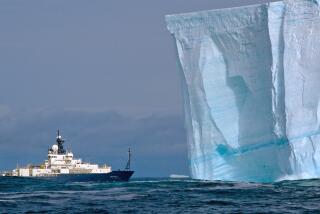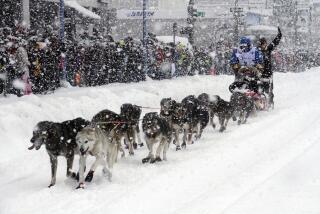The call of the wild fuels explorer’s North Pole dream
- Share via
ELY, MINN. — Twenty sled dogs are straining at their chains, rising on their hind legs to paw the air. They yelp at the humans who are untangling harnesses and choosing 10 lucky huskies who will go for a run in the snowy north woods.
The dogs are wilder than a neighborhood full of suburban mutts anticipating a ride in the car. The chosen ones appear ecstatic. The despair of those left behind is articulated by yowls that slip fluidly into the howling of wolves.
“Sled dogs live to pull,” says John Huston, polar expeditioner, dog musher, Antarctic history buff.
Huston lives mostly in northern Minnesota on the property of polar explorer Will Steger, where he supervises preparations for an upcoming expedition. Nearby Ely shivers under winter temperatures that drop lower than minus 20 and a wind chill that cuts to the bone. But that suits Huston, 30, just fine. He has long been drawn to the stillness and expansiveness of icy climates that most people avoid.
“It’s a true sense of being alive to one’s whole capacity,” he says. “Being out there, I’m connecting mentally with the people who have gone out before.”
Huston is base camp manager for Steger’s spring expedition to highlight global warming on Baffin Island, in northeast Canada. Huston is coordinating the trip’s logistics at Steger’s sprawling Ely compound bordering Superior National Forest and will travel to the Arctic island for the expedition.
This won’t be Huston’s first trip to the far north. He has organized logistics for a past expedition, gone on dog-sled trips to Hudson Bay and trekked hundreds of miles across Greenland’s ice shelf for a re-creation of the 1911-1912 race to the South Pole.
The show, broadcast on the History Channel this month, was filmed in Greenland because international agreements forbid people from introducing dogs and most other nonnative species into the Antarctic.
Huston plans to eventually tackle the North Pole. He and a partner, an Ely wilderness instructor named Tyler Fish, hope to be the first Americans to ski to the North Pole without outside assistance or supply drops, in 2009. They plan to haul their own sleds. The two adventurers will launch several smaller expeditions in the meantime to help them get ready.
But this day Huston and dog trainer Nancy Moundalexis, who also works for Steger, are running the dogs closer to civilization. A soggy snow is chalking out the landscape of white pines, but the weather has been unseasonably mild.
When the snow is thin, Huston and Moundalexis hitch the huskies to an all-terrain vehicle, which they pull. When the ground cover lies thicker, the dogs pull sleds.
“They feel a lot more comfortable if you are the one who’s in charge and they know the structure, because that’s their pack structure: to have an alpha,” Moundalexis says.
Huston became interested in uncharted regions as a boy. At Northwestern University, where he graduated in 1999 with a degree in anthropology and history, he began leading outdoor trips that eventually led to a job in Ely with Outward Bound, a nonprofit educational organization that provides wilderness experiences. He led canoe and sled-dog trips and camped out 200 nights a year.
It was there he deepened his interest in polar exploration, particularly the race to the South Pole between the Norwegian Roald Amundsen and Briton Robert Falcon Scott.
Amundsen’s team won through an innovative combination of Norwegian skiing and Inuit sled-driving. Scott and his men were inexpert skiers who set off later in the austral summer because they were taking Siberian ponies in addition to hardier dogs. All five men who attempted the pole perished and are buried in the Antarctic ice.
Several years ago, Huston learned that film producers were planning to recreate the race using period equipment: dog sleds, furs instead of Gore-Tex jackets and canvas tents. Expeditioners would even eat the kind of food the original explorers ate: hard tack and pemmican made of salami, raisins, dried peas, pork lard and honey (“It was just absolutely disgusting,” Huston says).
Norwegians were to restage Amundsen’s team, while British would use Scott’s logistics. The producer was searching for an English-speaking musher so the Norwegians would remember to speak that language for the cameras. Huston won a place on the 2005 trip.
On the trek, Huston learned lessons that might apply in future trips. Rune Gjeldnes, the leader of Huston’s team and an accomplished polar explorer, maintained a positive outlook. Every morning he declared, “Today is going to be a great day,” Huston says.
His outlook was infectious. The men refused to give into pessimism even when 80-mph winds threatened to rip apart their tent and leave them exposed on the ice shelf, or when they thought they couldn’t gag down another bite of pemmican. Food fantasies sustained them.
“We would joke about it,” Huston says. “One night it would be Hungarian goulash pemmican. The next night it would be Mexican pemmican. So it was like, ‘OK, what’s for dinner tonight?’ ‘Oh, we’ve got Mexican pemmican!’ ‘OK, great!’ ”
For this spring’s Baffin Island expedition, Huston will be traveling ahead to small Inuit towns preparing logistics.
He also will be posting Internet lessons on global warming for schoolchildren and answering their questions. Huston and Fish likewise plan to make their North Pole journey a chance to educate children.
They aren’t blind to the dangers. Fissures split the Arctic ice cap in the summer, leaving open water to cross. Huston and Fish plan to swim across in dry suits, towing their floatable sledges.
Harald Kippenes, Norwegian navigator for the Greenland expedition, said in a phone interview from Oslo that he is confident Huston will succeed in future polar ventures.
“He has a great chance to reach the North Pole,” Kippenes says. “He has the skills and the curiosity to keep on going ... and he is able to make sound judgments even in these harsh storms and cold temperatures, which we had in Greenland sometimes.”
For some, mushing dogs for weeks across a polar ice shelf would sound bleak: the white horizons, the days that blend into each other. But Huston feels a sense of urgency in his journeys. Glaciers and ice caps are retreating. In a few decades, humans may not be able to ski to the North Pole, he says.
And as one who grew up reading adventure stories and became entranced by Antarctic history, Huston considers himself fortunate.
“People live vicariously through characters in stories,” Huston says. “I got to go be in my favorite book.”
More to Read
Sign up for Essential California
The most important California stories and recommendations in your inbox every morning.
You may occasionally receive promotional content from the Los Angeles Times.













